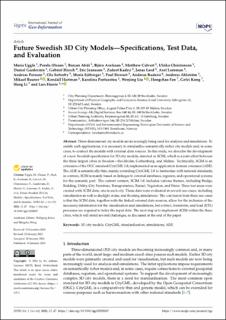Future Swedish 3D City Models—Specifications, Test Data, and Evaluation
| dc.contributor.author | Uggla, Maria | |
| dc.contributor.author | Olsson, Perola | |
| dc.contributor.author | Abdi, Barzan | |
| dc.contributor.author | Axelsson, Björn | |
| dc.contributor.author | Calvert, Matthew | |
| dc.contributor.author | Christensen, Ulrika | |
| dc.contributor.author | Gardevärn, Daniel | |
| dc.contributor.author | Hirsch, Gabriel | |
| dc.contributor.author | Jeansson, Eric | |
| dc.contributor.author | Kadric, Zuhret | |
| dc.contributor.author | Lord, Jonas | |
| dc.contributor.author | Loreman, Axel | |
| dc.contributor.author | Persson, Andreas | |
| dc.contributor.author | Setterby, Ola | |
| dc.contributor.author | Sjöberger, Maria | |
| dc.contributor.author | Stewart, Paul | |
| dc.contributor.author | Rudenå, Andreas | |
| dc.contributor.author | Ahlström, Andreas | |
| dc.contributor.author | Bauner, Mikael | |
| dc.contributor.author | Hartman, Kendall | |
| dc.contributor.author | Pantazatou, Karolina | |
| dc.contributor.author | Liu, Wenjing | |
| dc.contributor.author | Fan, Hongchao | |
| dc.contributor.author | Kong, Gefei | |
| dc.contributor.author | Liu, Hang | |
| dc.contributor.author | Harrie, Lars | |
| dc.date.accessioned | 2023-10-30T08:21:45Z | |
| dc.date.available | 2023-10-30T08:21:45Z | |
| dc.date.created | 2023-03-13T10:33:43Z | |
| dc.date.issued | 2023 | |
| dc.identifier.citation | ISPRS International Journal of Geo-Information. 2023, 12 (2), . | en_US |
| dc.identifier.issn | 2220-9964 | |
| dc.identifier.uri | https://hdl.handle.net/11250/3099283 | |
| dc.description.abstract | Three-dimensional city models are increasingly being used for analyses and simulations. To enable such applications, it is necessary to standardise semantically richer city models and, in some cases, to connect the models with external data sources. In this study, we describe the development of a new Swedish specification for 3D city models, denoted as 3CIM, which is a joint effort between the three largest cities in Sweden—Stockholm, Gothenburg, and Malmö. Technically, 3CIM is an extension of the OGC standard CityGML 2.0, implemented as an application domain extension (ADE). The ADE is semantically thin, mainly extending CityGML 2.0 to harmonise with national standards; in contrast, 3CIM is mainly based on linkages to external databases, registers, and operational systems for the semantic part. The current version, 3CIM 1.0, includes various themes, including Bridge, Building, Utility, City Furniture, Transportation, Tunnel, Vegetation, and Water. Three test areas were created with 3CIM data, one in each city. These data were evaluated in several use-cases, including visualisation as well as daylight, noise, and flooding simulations. The conclusion from these use-cases is that the 3CIM data, together with the linked external data sources, allow for the inclusion of the necessary information for the visualisation and simulations, but extract, transform, and load (ETL) processes are required to tailor the input data. The next step is to implement 3CIM within the three cities, which will entail several challenges, as discussed at the end of the paper. | en_US |
| dc.language.iso | eng | en_US |
| dc.publisher | MDPI | en_US |
| dc.rights | Navngivelse 4.0 Internasjonal | * |
| dc.rights.uri | http://creativecommons.org/licenses/by/4.0/deed.no | * |
| dc.title | Future Swedish 3D City Models—Specifications, Test Data, and Evaluation | en_US |
| dc.title.alternative | Future Swedish 3D City Models—Specifications, Test Data, and Evaluation | en_US |
| dc.type | Peer reviewed | en_US |
| dc.type | Journal article | en_US |
| dc.description.version | publishedVersion | en_US |
| dc.source.pagenumber | 0 | en_US |
| dc.source.volume | 12 | en_US |
| dc.source.journal | ISPRS International Journal of Geo-Information | en_US |
| dc.source.issue | 2 | en_US |
| dc.identifier.doi | 10.3390/ijgi12020047 | |
| dc.identifier.cristin | 2133411 | |
| cristin.ispublished | true | |
| cristin.fulltext | original | |
| cristin.qualitycode | 1 |

